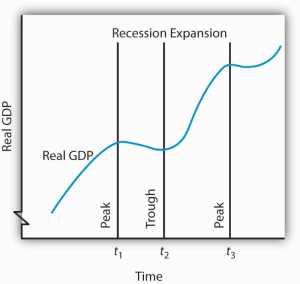4.8 Business Cycles
Figure 4.11, “Phases of the Business Cycle,” shows a stylized picture of a typical business cycle. It shows that economies go through periods of increasing and decreasing real GDP but that, over time, they generally move toward increasing real GDP. A sustained period in which real GDP is rising is an expansion; a sustained period in which real GDP is falling is a recession. An economy is typically in a recession when real GDP drops for two consecutive quarters. Typically, a business cycle has two phases: expansion and recession and two turning points, peak and trough.

At time [latex]t1[/latex] in Fig 4.11, an expansion ends, and real GDP turns downward. The point at which an expansion ends and a recession begins is called the peak of the business cycle. Real GDP then falls during a period of recession. Eventually, it starts upward again (at time [latex]t2[/latex]). The point at which a recession ends and an expansion begins is called the trough of the business cycle. The expansion continues until another peak is reached at time [latex]t3[/latex]. A complete business cycle is defined by the passage from one peak to the next.
Attribution
“5.1 Growth of Real GDP and Business Cycles” from Principles of Macroeconomics by University of Minnesota is licensed under a Creative Commons Attribution-NonCommercial-ShareAlike 4.0 International License, except where otherwise noted.

